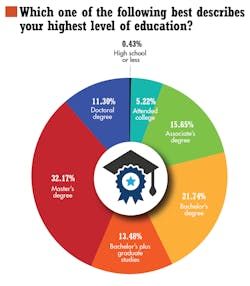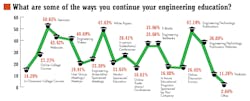2022 Salary & Career Report: Continuing Education
This article is part of the Professional Advancement Series: Annual Salary Survey
Members can download this article in PDF format.
What you'll learn:
- The different ways that engineers are continuing their education.
- Why time has become a challenge to stay current with industry trends and advances.
- Do companies support engineers to continue their educational efforts?
When asked about the biggest challenges in staying current with relevant engineering information, one respondent to our 2022 Salary & Career Report survey replied, “It’s having adequate time to get future-proof design knowledge and the willingness of management to learn, innovate, and invest in technology.” That’s a representative example of the attitude among engineers about refreshing and/or continuing their engineering educations. There’s certainly no shortage of new technologies to stay abreast of, making continuing education a perennial requirement.
In our survey, we asked you to update us on your current level of education and how you prefer to learn about new technologies and skills. Does your employer encourage continuing education by footing the bill, and if so, in what modes? And how does the coronavirus pandemic figure into the picture? In this article, we’ll look at these topics with facts, figures, and anecdotal responses.
Education Levels Declining
First, let’s look at where you stand with your respective highest levels of education and see how that compares with the 2021 survey responses. The leading response was a master’s degree (32% vs. 46% in 2021), followed by a bachelor’s degree (22% vs. 19%). Over 13% claim a bachelor’s degree plus some amount of graduate studies. However, at 11%, the number of respondents holding a doctoral degree has dropped from 14% in 2021.
Thus, these survey results suggest that overall, the levels of education among you are declining a bit year on year compared to 2021 at the higher levels of academia.
A Bevy of Educational Options for Engineers
Whether you pursued an engineering career with little or no college-level education or went all the way to a PhD, you still need to keep on top of technology’s evolution as you make your way in the industry. So, as we do each year, we asked, “What are some of the ways in which you continue your engineering education?”
The results, as usual, were a mixed bag. Curiously, though, more categories of educational options have fallen off in usage since last year’s survey than those that have grown. More than anything other than the anecdotal responses to the survey, this fact points to the time crunch engineers are under in their day-to-day lives.
Vendors to the OEM electronics industry have always done a great job at cranking out videos, white papers, and webcasts to educate engineers on their latest and greatest innovations. All of those mediums are free to consume, and webcasts can usually be viewed on demand if you’ve missed the live events.
This year’s leading category among continuing education options is seminars—nearly 51% of respondents rely on them for information on new technologies. That’s a drop-off from 63% in 2021. About 48% favor white papers (down from 67% in 2021), while 47% like engineering publications (down from 71% last year). Webcasts are down to 42% from 58% last year.
Use of engineering textbooks has fallen way off from 56% in 2021 to just 35% in 2022. And eBook usage also has dropped from 42% last year to 35% this year.
Among the education options, which more respondents say they’re looking to in 2022 compared with 2021, are in-classroom college courses (over 14% in 2022 vs. 11% in 2021), online college courses (27% vs. 20%), user group meetings/meetups (20% vs. 17%), engineering association-sponsored meetings (over 23% vs. 17%), and in-person trade shows and conferences (26.4% vs. 26%).
It’s interesting that the in-person modes of continuing education—things like in-classroom college courses, user-group meetings, and meetups—comprise most of the education categories seeing more usage this year than last year. Even though COVID-19 is still with us in its various strains, it seems that more engineers are willing to take the risks that come with being out and about and in groups. Hopefully, that trend will continue as we turn the calendar over to 2023 and beyond.
It’s About Time
Our survey indicates that fear of contracting disease is no longer the big barrier to continuing education that it was in 2020 and part of last year. Lack of time is what stymies engineers the most. “It’s a challenge to find the time to educate myself, improve, and stay current while still performing all my work duties and maintaining work-life balance and supporting my family,” said one respondent. Another chimed in with “Too much time is consumed by trivial tasks at work.”
As noted above, work-life imbalance is an ever-present issue for engineers, and not everyone wants to take home training materials or extracurricular reading. “Balancing work and life while keeping up with new trends is very difficult,” offered one respondent. Indeed, many respondents would rather do it on company time, but it’s just not possible: “I have over an hour commute each way, which is time I can't spend studying.”
Another oft-cited roadblock is the sheer volume of material to be sifted through and prioritized. “Parsing which technological advances are relevant to my company, and how soon they will be available or reasonably priced, is part of the problem” said one respondent. Meanwhile, another laments that “I cut a large swath from RF to digital to embedded software to CAD. It is hard to stay current across all of it.” Still others cite the combination of the pace of change in the industry and the number of topics to keep abreast of.
To be sure, there’s no shortage of information to be had. Some respondents mentioned the need to vet information, both in terms of accuracy and its relevance to current projects.
Employer Support is a Mixed Bag
Finally, we asked whether your employer invests in its engineering staff through reimbursement of the costs of continuing education. Our 2021 survey showed a broad downward trend in support for employees. This year, the results have unfortunately declined again in most categories.
First, the good news: Here are some examples of cases in which employers are being more generous. When it comes to the cost of online tradeshows and conferences, 30.5% of employers helped this year vs. 20% last year. They were a bit more generous for engineering textbooks (27% vs. 25.5%) and with engineering association dues (25% vs. 21.5%).
But sadly, in many other modes of education, employers in 2022 are less supportive of their staffs’ professional growth. Seminars (33% in 2022 vs. 38% in 2021), in-person tradeshows/conferences (37% vs. 39%), college tuition (26% vs. 31.7%), certifications (23% vs. 29%), and online training (26.6% vs. 32%) have all seen declines in the number of respondents saying their employers helped foot the bill.
Even though employer support is down for many facets of continuing engineering education, only 14.5% of 2022 respondents told us that their employers didn’t support continuing education at all. In 2021, 27% said they got no help in any respect. So, overall, it seems that more employers are helping in some way than not at all, and likely in lesser amounts when they do.
Without a doubt, staying on top of technology trends and project-relevant information is a difficult endeavor. Here’s hoping you’re able to maintain and expand your knowledge base sufficiently in 2023 to keep you at the top of your game.




